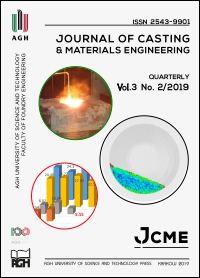Recycling of Dispersed Metal Wastes in Rotary Furnaces
DOI:
https://doi.org/10.7494/jcme.2019.3.2.43Abstract
The recycling of dispersed metal containing wastes is a considerable problem, as their accumulation in dumps today is commensurate with the volume of ore extraction. Several methods and technologies are developed to recycle metal containing wastes but almost all of them require the preliminary preparation of wastes resulting in an increased price of the recycled metals. Furthermore, it is especially difficult to recycle dispersed multicomponent wastes and, therefore, the problem of developing effective, flexible and reliable technology for recycling of dispersed metal containing wastes is still a pressing one.
The article presents an alternative method of recycling dispersed iron-containing wastes based on a continuous solid-liquid process of iron oxides reduction in rotary tilting furnaces (RTF). The new method allows the processing of waste of almost any composition and state: from metal lumps to oxide and multicomponent (chips, scale, sludge, etc.) wastes, contaminated with moisture, oils, organic impurities without their preliminary preparation (cleaning, homogenization, pelletizing, etc.). The result of recycling is the production of cast iron or steel ingots or required casting alloys. Some features of technology are considered, including the gas flow and motion of charge metal particles within the RTF. Process parameters providing high metal output are established.
Downloads
References
Recovering metals from waste. Retrieved from: https://www.metso.com/industries/waste-recycling/waste-types/metals/ (accessed 17.08.2018).
Valavin V., Makeev S., Dr. Pokhvisnev Yu., Zaytsev A. & Popov A.
(2012). Recycling of Iron-Containing Waste of Metallurgical Works in the Countries of Black Sea Economic Cooperation (BSEC). IX International Congress "Machines, Technologies, Materials". 1, (pp. 79–81).
Bogdandy L. & Engell H.-J. (2013). The Reduction of Iron Ores – Scientific Basis and Technology. Berlin: Springer/Link.
Rovin S.L. (2015). Ryetsиklиnh myetallootkhodov vrotatsиonnykh pyechakh. Minsk: Belarusian National Technical University. [Ровин С.Л. (2015). Рециклинг металлоотходов вротационных печах. Минск: Белорусский Национальный Технический Университет].
Schmitz C. (2003). Handbook of Aluminium Recycling. Essen: Vulkan-Verlag GmbH.
Rovin S.L. (2016). Issledovaniye raboty rotatsionnykh naklonyayushchikhsya plavil'nykh pechey. Nauka i Tekhnika, 15(1), 18–28. Doi:10.21122/2227-1031-2016-15-1-18-28 [Ровин С.Л. (2016). исследование работы ротационных наклоняющихся плавильных печей. Наука и Техника. 15(1), 18–28. Doi:10.21122/2227-1031-2016-15-1-18-28].
Warnatz J., Maas U. & Dibble R.W. (2006). Combustion. Physical and Chemical Fundamentals, Modeling and Simulation, Experiments, Pollutant Formation. Berlin: Springer-Verlag Berlin Heidelberg GmbH.
Sonavane Y. & Specht E. (2008). Numerical analysis of the heat transfer in the wall of rotary kiln using finite element method ANSYS. 7th International Conference on CFD in the Minerals and Process Industries: December 9–11. Melbourne, Australia.
(pp. 1–5). CSIRO.
Norouzi H.R., Zarghami R., Sotudeh-Gharebagh R. & Mostoufi N. (2016). Coupled CFD-DEM modeling: formulation, implementation and application to multiphase flows. Chichester: John Wiley & Sons.
Rovin S.L., Rovin L.E., Zharanov V.A. & Mazurov V.S. (2017). Dvizheniye i smeshivaniye dispersnykh materialov vrotatsionnykh pechakh. Lit'ye i metallurgiya, 2, 117–127. Doi:10.21122/1683-6065-2017-2-117-127. [Ровин С.Л., Ровин Л.Е., Жаранов В.А. & Мазуров В.С. (2017). Движение и смешивание дисперсных материалов в ротационных печах. Литье и металлургия. 2, 117–127. Doi:10.21122/1683-6065-2017-2-117-127].
Rovin S.L. & Kalinichenko A.S. (2017). Primeneniye rotatsionnykh naklonyayushchikhsya pechey dlya organizatsii bezotkhodnogo oborota metallov na mashinostroitel'nykh predpriyatiyakh i proizvodstva otlivok. ITB "Lit'ye Ukrainy". (8), 2–8. [Ровин С.Л. & Калиниченко А.С. (2017). Применение ротационных наклоняющихся печей для организации безотходного оборота металлов на машиностроительных предприятиях и производства отливок. ИТБ "Литье Украины", 8 (204), 2–8].
Negami T. (2000). Premium iron shot making by ITmk3. Commercializing new hot metal processes beyond the blast furnace. Gorham conference proceeding. Atlanta, Georgia, USA. (pp. 171–176).
Downloads
Published
Issue
Section
How to Cite
Accepted 2019-07-11
Published 2019-07-31


